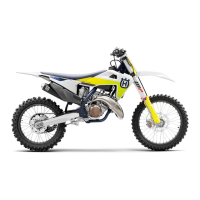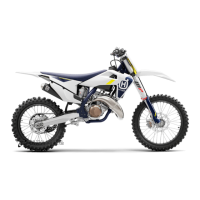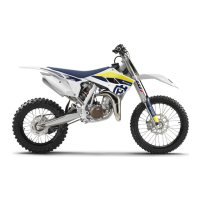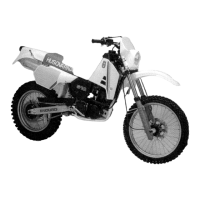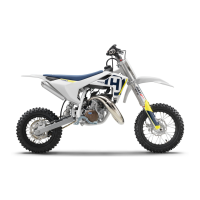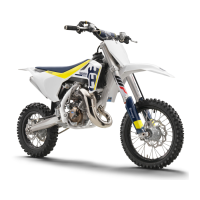10 TUNING THE CHASSIS 38
– Remove the motorcycle from the lift stand. ( p. 43)
10.11 Adjusting the riding sag
Preparatory work
– Raise the motorcycle with a lift stand. ( p. 43)
– Remove the shock absorber. ( p. 51)
– After removing the shock absorber, clean it thoroughly.
B00292-10
Main work
– Choose and mount a suitable spring.
Guideline
Spring rate (TC 125)
Weight of rider: 65… 75 kg (143…
165 lb.)
36 N/mm (206 lb/in)
Weight of rider: 75… 85 kg (165…
187 lb.)
39 N/mm (223 lb/in)
Weight of rider: 85… 95 kg (187…
209 lb.)
42 N/mm (240 lb/in)
Spring rate (TC 250)
Weight of rider: 65… 75 kg (143…
165 lb.)
39 N/mm (223 lb/in)
Weight of rider: 75… 85 kg (165…
187 lb.)
42 N/mm (240 lb/in)
Weight of rider: 85… 95 kg (187…
209 lb.)
45 N/mm (257 lb/in)
Spring rate (TX 300)
Weight of rider: 65… 75 kg (143…
165 lb.)
39 N/mm (223 lb/in)
Weight of rider: 75… 85 kg (165…
187 lb.)
42 N/mm (240 lb/in)
Weight of rider: 85… 95 kg (187…
209 lb.)
45 N/mm (257 lb/in)
Info
The spring rate is shown on the outside of the spring.
Finishing work
– Install the shock absorber. ( p. 52)
– Remove the motorcycle from the lift stand. ( p. 43)
– Check the static sag of the shock absorber. ( p. 36)
– Check the riding sag of the shock absorber. ( p. 37)
– Adjust the rebound damping of the shock absorber. ( p. 35)
10.12 Checking the basic setting of the fork
Info
For various reasons, no exact riding sag can be determined for the fork.
401000-01
– Smaller differences in the rider's weight can be compensated for by the fork air
pressure.
– However, if the fork frequently bottoms out (hard end stop on compression), the
fork air pressure must be increased, within the specified values, to avoid damage
to the fork and frame.
– If the fork feels unusually hard after extended periods of operation, the fork legs
need to be bled.
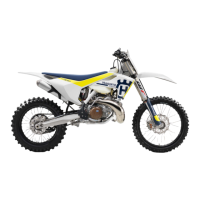
